Intel Dual Core Performance Preview Part I: First Encounter
by Anand Lal Shimpi on April 4, 2005 2:44 PM EST- Posted in
- CPUs
Business Application Performance
Business Winstone 2004
Business Winstone 2004 tests the following applications in various usage scenarios:- Microsoft Access 2002
- Microsoft Excel 2002
- Microsoft FrontPage 2002
- Microsoft Outlook 2002
- Microsoft PowerPoint 2002
- Microsoft Project 2002
- Microsoft Word 2002
- Norton AntiVirus Professional Edition 2003
- WinZip 8.1

There's no surprise here - your best business application performance is going to come from a very fast single core CPU.
Office Productivity SYSMark 2004
SYSMark's Office Productivity suite consists of three tests, the first of which is the Communication test. The Communication test consists of the following:"The user receives an email in Outlook 2002 that contains a collection of documents in a zip file. The user reviews his email and updates his calendar while VirusScan 7.0 scans the system. The corporate web site is viewed in Internet Explorer 6.0. Finally, Internet Explorer is used to look at samples of the web pages and documents created during the scenario."
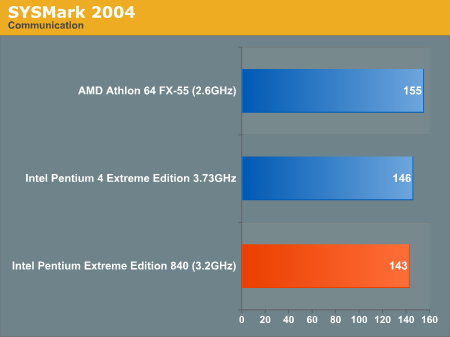
The next test is Document Creation performance:
"The user edits the document using Word 2002. He transcribes an audio file into a document using Dragon NaturallySpeaking 6. Once the document has all the necessary pieces in place, the user changes it into a portable format for easy and secure distribution using Acrobat 5.0.5. The user creates a marketing presentation in PowerPoint 2002 and adds elements to a slide show template."
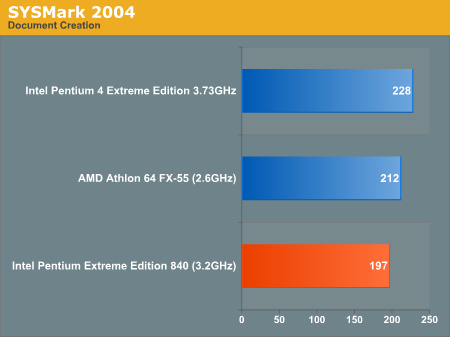
The final test in our Office Productivity suite is Data Analysis, which BAPCo describes as:
"The user opens a database using Access 2002 and runs some queries. A collection of documents are archived using WinZip 8.1. The queries' results are imported into a spreadsheet using Excel 2002 and are used to generate graphical charts."
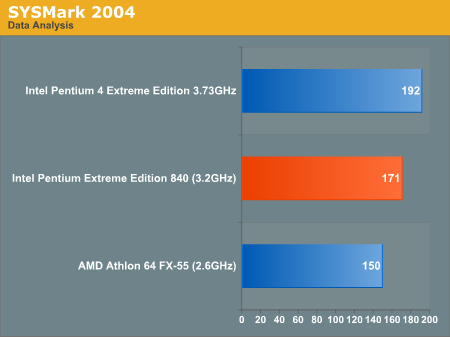
The Office Productivity SYSMark 2004 suite shows some benefit to dual core, given that there is quite a bit of multitasking involved in the test suite. Despite the multitasking, the Pentium Extreme Edition running at 3.2GHz isn't able to trounce its single core 3.73GHz relative.
Business Winstone 2004 includes a multitasking test as a part of its suite, which does the following:
"This test uses the same applications as the Business Winstone test, but runs some of them in the background. The test has three segments: in the first, files copy in the background while the script runs Microsoft Outlook and Internet Explorer in the foreground. The script waits for both foreground and background tasks to complete before starting the second segment. In that segment, Excel and Word operations run in the foreground while WinZip archives in the background. The script waits for both foreground and background tasks to complete before starting the third segment. In that segment, Norton AntiVirus runs a virus check in the background while Microsoft Excel, Microsoft Project, Microsoft Access, Microsoft PowerPoint, Microsoft FrontPage, and WinZip operations run in the foreground."
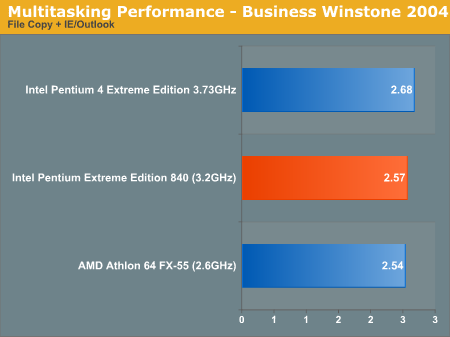
The performance of the dual core Extreme Edition comes within 5% of the 3.73GHz EE, despite the fact that the single core chip has a 16% clock speed advantage, but it is still slower overall.
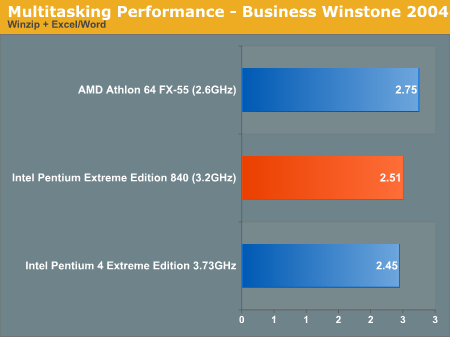
The second test finally shows something positive for the dual core chip, with a negligable 2% performance lead. This is the perfect example of how multi-core can be a substitute for clock speed when it comes to performance. Note that despite the Pentium Extreme Edition being faster than the 3.73EE, the single core Athlon 64 FX-55 is faster than both.
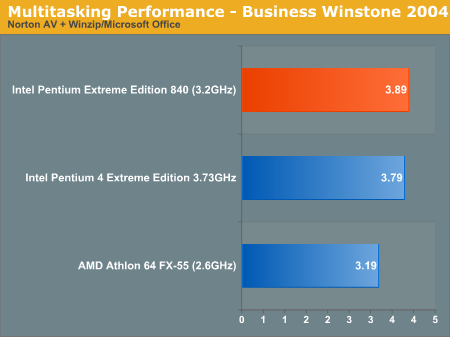
The third and final test also shows a slight performance advantage for the dual core Extreme Edition, even over the Athlon 64 FX-55.
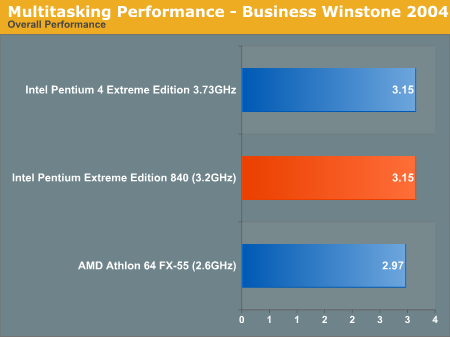










141 Comments
View All Comments
mlittl3 - Tuesday, April 5, 2005 - link
#90,Please, oh, please read Anand's blog from now on. He did just as you are suggesting a couple of days ago before the article was posted/written. He asked the readership for multitasking scenarios and he but those in the article.
Read his blogs. They are awesome.
Keep up the good work, Anand and Anandtech staff, and even though you don't have to give into the naysayers about lack of gaming benchmarks, thanks for being understanding and giving the readers what they want.
That is the sign of true journalistic integrity. :)
suryad - Tuesday, April 5, 2005 - link
As always great work Anand, and for all the users griping about the multitasking testing setup, well maybe Anand would be open to a set of multitasking suggestions his readers most regularly do. Maybe we can all offer suggestions and they will be tested for the second look probably sometime in the future on dual cores and hopefully AMD will have their bad boys out off the cage by then.Also benches on Linux would be great...64 bit and 32 bit.
Surya
Anand Lal Shimpi - Tuesday, April 5, 2005 - link
kjohnsonI'll let my actions speak for themselves, I've got gaming in Part II and surprisingly enough, it's no different than what I said in Part I - gaming performance of the dual core Pentium D is identical to a single core Pentium 4 of the same clock speed.
The multitasking tests in Part I were largely determined by responses to a "how do you multitask" question I posted in my blog on Friday. Out of the 65 responses, hardly any mentioned gaming as a multitasking scenario, so given my limited time with the system I decided to focus on what the readers asked for. That's also why I split the article into multiple parts, I knew that more performance testing would be desired but a desire for information would also be there on day one.
Insinuating that Intel somehow strong armed me into excluding certain benchmarks is just ignorant of how things work, at least at AnandTech. It's a great way to get attention but it's way off base. Intel told me when the system was shipping and when the NDA lifted, no more, no less. I spent all weekend putting together benchmarks that I thought the readership would like to see, not simply re-run benchmarks that we already had results of.
I've been doing this for 8 years, and the one thing I've always known is that it doesn't matter who is first to publish an article, but it is the article that does the best job and is the most thorough that matters. Trading integrity for exclusivity never makes sense, thinking it does requires a very short term memory and no sense of how things pan out in the long run. Being that in 3 weeks AnandTech will celebrate its 8th year anniversary, I don't think you can argue that type of thinking is characteristic of myself or anyone at this site.
But I'm not here to try and correct anyone's misconceptions of myself or this site, I'm here to deliver what the readers want and what will help you all make the best, most accurate purchasing decisions. In doing so I've taken every last comment to heart, as I always do, and I'm doing my best to incorporate your requests into Part II...just as I did in Part I.
As I mentioned in my blog, I'm an open book with nothing to hide, if there are questions of integrity or ethics fire away and I'll be more than happy to answer them.
Take care,
Anand
Amagus - Tuesday, April 5, 2005 - link
Wow that Inquirer article basically insinuates that Anand (it's obvious who he's referring to) was bought out because part I of a preview (!!) didn't contain any gaming benchmarks. I wouldn't stand for that.blwest - Tuesday, April 5, 2005 - link
Nice article, as always. I wonder how memory bandwidth increases/decreases will effect the performance of the already bandwidth hungry intel processors.michael2k - Tuesday, April 5, 2005 - link
#83, #85Gaming wasn't addressed because gaming, by itself, won't see huge improvements with dual core*
If you run IRC, AIM, FireFox, and BitTorrent while you game, then yes, you will see a performance increase, but not over a single core CPU running only the game by itself. A fast single core CPU will be much, much, better for a game. Or if you run WoW and EQ on two monitors, you will see a benefit.
*Drastic rewrites of OpenGL and DirectX will see benefits with dual core. For example, if front and back buffers were handled by different CPUs, or if you can split the screen into to sections and have one half processed by one CPU and the other half by another. Another performance technique might be to let one CPU deal with vertex culling, occlusion, and decomposition, while the other CPU deals with shadow calculations, or something suitably complex. But that requires the game to be written for dual core, and won't appear on games already on the market.
kjohnson - Tuesday, April 5, 2005 - link
Here's why this article does not mention any gaming benchmarks:http://www.theinquirer.net/?article=22332.bdchambers79 - Tuesday, April 5, 2005 - link
I just thought I'd say, I often run the Persistance of Vision Raytracer (www.povray.org) in the background on my computer for several hours (or days... hehe) at a time. While it's running, I am able to do little more than edit text. However, I also like to code and play games.So, what I would like to see would be POV-Ray running in the background, with MS Dev Studio or GCC running multiple times in the foreground; or, POV-Ray in the background with a game (NOT necessarily Doom3, guys, though it would be a good benchmark) in the foreground (perhaps in a window, so you can see POV's results). Or, for those truly masochistic souls, POV, DevStudio and Doom3 all running at the same time (though that's less likely to occur in RL) :)
BLHealthy4life - Tuesday, April 5, 2005 - link
I didn't read every single post here, but i do hope that it's ben mentioned that there were wasn't one single game run on this system. Surely this will be done in part two??fitten - Tuesday, April 5, 2005 - link
#80, that kind of change won't happen withough redigning the memory interface (of either) which would mean that current motherboards wouldn't be able to use the parts (which at least AMD is claiming will be possible).